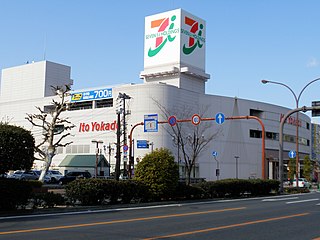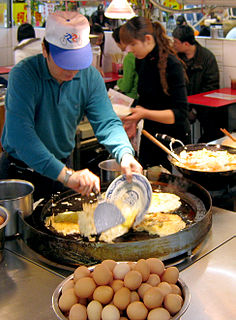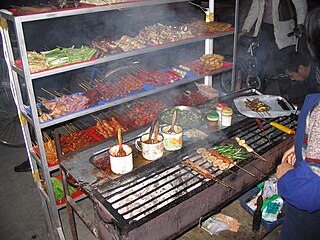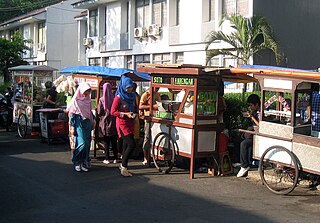
American Chinese cuisine is a style of Chinese cuisine developed by Americans of Chinese descent. The dishes served in many North American Chinese restaurants are adapted to American tastes and often differ significantly from those found in China.

Vietnamese cuisine encompasses the foods and beverages of Vietnam, and features a combination of five fundamental tastes in the overall meal. Each Vietnamese dish has a distinctive flavor which reflects one or more of these elements. Common ingredients include fish sauce, shrimp paste, soy sauce, bean sauce, rice, fresh herbs, fruit and vegetables. Vietnamese recipes use lemongrass, ginger, mint, Vietnamese mint, long coriander, Saigon cinnamon, bird's eye chili, lime, and Thai basil leaves. Traditional Vietnamese cooking is greatly admired for its fresh ingredients, minimal use of dairy and oil, complementary textures, and reliance on herbs and vegetables. With the balance between fresh herbs and meats and a selective use of spices to reach a fine taste, Vietnamese food is considered one of the healthiest cuisines worldwide. Due to the Chinese domination of Vietnam, Vietnamese cuisine is heavily influenced by traditional Chinese medicine.

A hawker centre or cooked food centre is an open-air complex in Singapore, Malaysia, Indonesia, Hong Kong, and the Riau Islands in Indonesia housing many stalls that sell a variety of inexpensive food. They are typically found in city centres, near public housing estates or transport hubs.

Stinky tofu is a Chinese form of fermented tofu that has a strong odor. It is usually sold at night markets or roadside stands as a snack, or in lunch bars as a side dish, rather than in restaurants.

Cellophane noodles, or Fensi, sometimes nicknamed as glass noodles, are a type of transparent noodle made from starch and water.

Dai pai dong is a type of open-air food stall in Hong Kong. The government registration name in Hong Kong is "cooked-food stalls", but dai pai dong literally means "big licence stall", referring to its size of licence which is bigger than other licensed street vendors. Founded after the Second world war,Dai Pai Dong is regarded as make good use of space,since most of them incorporated themselves into surrounding buildings and streets. For instance,the Dai Pai Dong in Central and Western areas are regard as terrace type Dai Pai Dongsince most of the streets were built along the maintain landscape,therefore the stall also organised on different terrace,which fully reflected the wits of local design.Until 1970s Hong Kong government decided to restrict the operation and licence of Dai Pai Dong due to the issue of hygiene and extension,the Dai Pai Dong started move into the cooked food market assigned by the government,the courtyard type Dai Pai Dong appears,which located the dinning area in the center of the area and the stalls are periphery of the courtyard. After the decline of Dai Pai Dong in 1970s,most of the Dai Pai Dong not longer operate in family but sole proprietorship or partnership instead,also the wok hei and fried dishes started in later stage of Dai Pai Dong evolutionwhich develop into the most down-to-earth culture and cuisine in Hong Kong nowadays.According to the Food and Environmental Hygiene Department, there are only 25 dai pai dong remaining in Hong Kong.As one of the most valuable heritage of Hong Kong culture, the word Dai Pai Dong regard as a formal wording by Oxford English Dictionary in 2016 March.

Penang cuisine is the cuisine of the multicultural society of Penang, Malaysia. Most of these cuisine are sold at road-side stalls, known as "hawker food" and colloquially as 'muckan carts'. Local Penangites typically find these hawker fares cheaper and easier to eat out at due to the ubiquitousness of the hawker stalls and that they are open for much of the day and night. Penang island. On February 22, 2013, Penang was ranked by CNN Travel as one of the top ten street food cities in Asia. Penang has also been voted by Lonely Planet as the top culinary destination in 2014.

Ito-Yokado is a Japanese general merchandise store, part of Seven & I Holdings Co. As of March 2013, there are 178 Ito-Yokado stores operating in Japan. Since entering the Chinese market in 1997, opening their first store in the Chunxilu shopping district of Chengdu, the company operates eight stores in Beijing and six in Chengdu. The company formed a joint venture with Wangfujing Department Store and China Huafu Trade & Development Group Corp. to open one of five stores in Beijing. As of January 2013, there are fourteen stores in China.

Night markets in Taiwan are street markets in Taiwan that operate in urban or suburban areas. They are similar to those in areas inhabited by ethnic Han, such as Southeast Asia. A few, such as Huaxi Street Tourist Night Market, utilize purpose-built marketplaces but most occupy either sidewalks (pavements) adjacent to streets or entire streets that are normal thoroughfares by day. Some night markets in smaller side streets or lanes feature retractable roofs. Most of the markets operate daily and feature a mixture of individual stalls hawking clothing, consumer goods, xiaochi, and specialty drinks. The atmosphere is usually crowded and noisy with hawkers shouting and fast-paced music playing over loudspeakers. Taiwan Night Markets changed from small local gatherings to noisy streets lined up with vendors. These vendors have to adhere to some laws set by the Taiwanese Government. There are vendors selling food in some of the most famous Night Markets all around Taiwan. There are many night markets in Taiwan.

Beijing apm, also known as Xindong'an Plaza, is a shopping mall and office building at Wangfujing, Beijing, China. It is a commercial property developed by Sun Hung Kai Properties. It has a total area of 120,000 sq.m.

Xiaochi are an important category of Chinese and Taiwanese street food, commonly found in ethnically Chinese areas in China, Taiwan, and around the world. Xiaochi are substantial snacks, which could be eaten together or with more substantial dishes like the Spanish tapas or Middle Eastern Levantine meze, or alone as a light meal or snack like the French goûter.

Street foods, ready-to-eat food or drink sold in a street or other public place, such as a market or fair, by a hawker or vendor, often from a portable stall, have variations within both regions and cultures. For example, Dorling Kindersley describes the street food of Viet Nam as being "fresh and lighter than many of the cuisines in the area" and "draw[ing] heavily on herbs, chile peppers and lime," while street food of Thailand is "fiery" and "pungent with shrimp paste... and fish sauce" with New York City's signature street food being the hot dog, although the offerings in New York also range from "spicy Middle Eastern falafel or Jamaican jerk chicken to Belgian waffles." In Hawaii, the local street food tradition of "Plate Lunch" was inspired by the bento of the Japanese who had been brought to Hawaii as plantation workers.

Shaokao, also romanized as shao kao, is the Chinese translation of "barbecue". Chinese variants of the practice constitute a significant aspect of Chinese cuisine. In China, it is predominantly found on busy Chinese streets and night markets as a street food sold in food stalls and is a type of xiaochi. In China and elsewhere, such as in the United States, diners sometimes also order beer as an accompaniment.
Street food in South Korea has traditionally been seen as a part of popular culture in Korea. Historically, street food mainly included foods such as Eomuk, Bungeo-ppang and Tteok-bokki. Street food has been sold through many types of retail outlet, with new ones being developed over time. Recently, street food has seen a popular resurgence in South Korea, such as at the Night Market at Hangang Park, which is called "Bamdokkaebi Night Market"(밤도깨비야시장).

Indonesian street food is a collection of ready-to-eat meals, snacks, fruits and drinks sold by hawkers or vendors at warung food stalls or food carts. Street food in Indonesia is a diverse mix of local Indonesian, Chinese, and Dutch influences. Indonesian street food are usually cheap, offer a great variety of food of different tastes, and can be found on every corner of the city.

Street food in Thailand brings together various offerings of ready-to-eat meals, snacks, fruits and drinks sold by hawkers or vendors at food stalls or food carts on the street side in Thailand. Sampling Thai street food is a popular activity for visitors, as it offers a taste of Thai cooking traditions. Bangkok is often mentioned as one of the best place for street food. In 2012, VirtualTourist named Bangkok as the number one spot for street food—the city is notable for both its variety of offerings and the abundance of street hawkers.






















